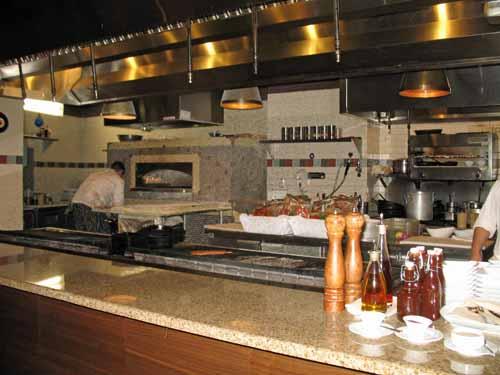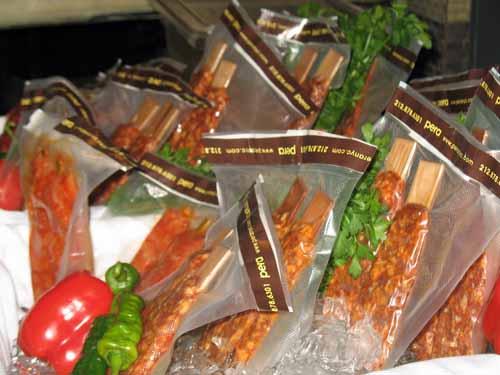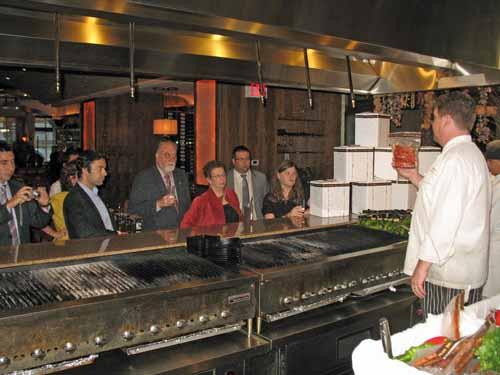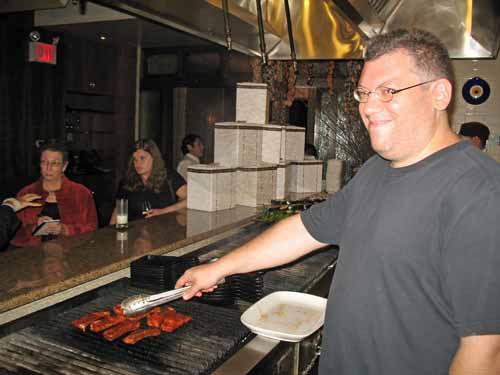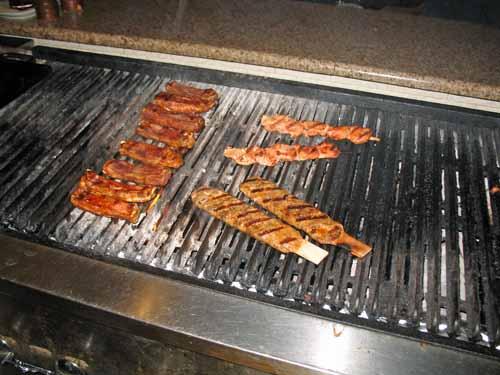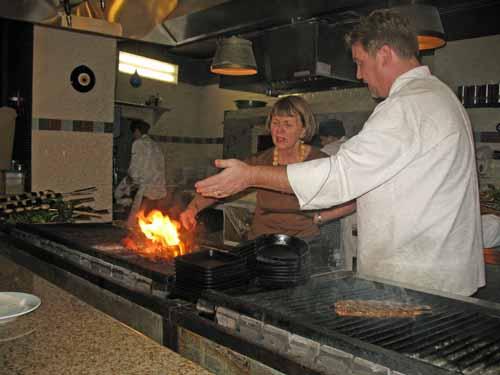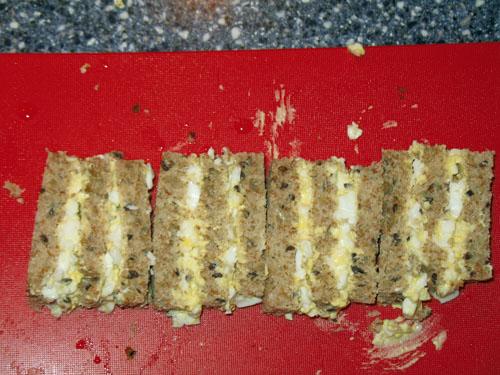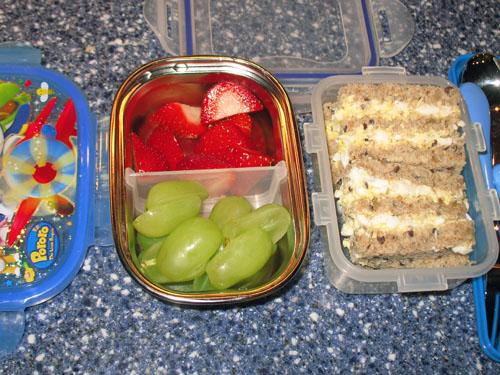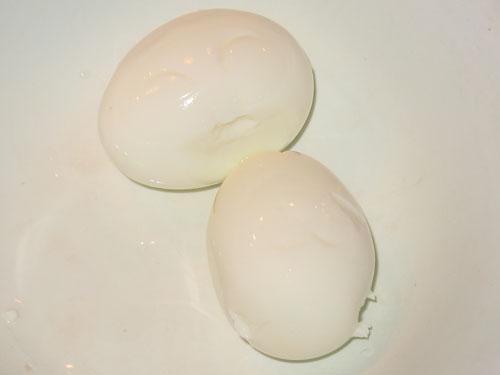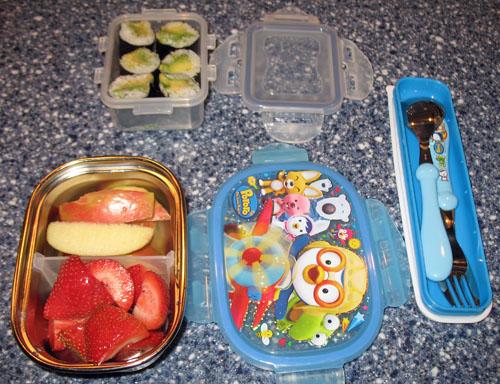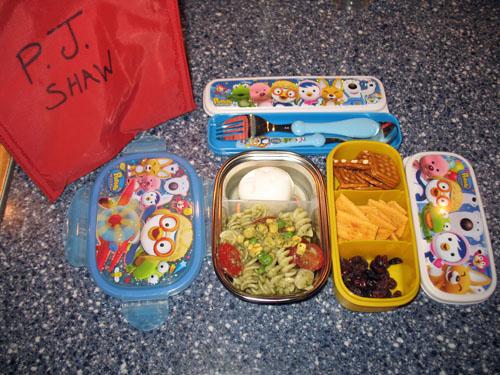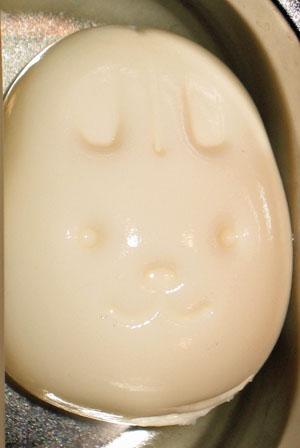-
Posts
28,458 -
Joined
-
Last visited
Content Type
Profiles
Forums
Store
Help Articles
Everything posted by Fat Guy
-
I would not characterize Ghirardelli brownie mix as a crummy product. It doesn't contain a lot of garbage: That being said, I wouldn't go nearly as far as saying that Ghirardelli brownie mix is better than any from-scratch recipe. If you make them with better chocolate and real butter (as opposed to the combination of soybean and cottonseed oils and "natural butter flavor") and you're reasonably competent at following directions, they come out better. (Edited to add: I recently had one of Jenn Giblin's brownies. She's the pastry chef at Blue Smoke, a restaurant here in New York. There's certainly no comparison between her brownies and Ghirardelli brownies from a mix.) This is true of baking mixes in general. A lot of them are fine. Bisquick is fine too. I use it if I'm feeling lazy, just as I might use a brownie or cake mix for a low-priority batch. But, if you do this stuff from scratch, once you traverse the learning curve it does come out better.
-
Today there was an op-ed in the New York Times by Christopher Kimball, the editor of Cook's Illustrated, about the death of Gourmet. I thought it was about as poorly reasoned and self-indulgent an op-ed as could have been written on the subject. Rather than provide any insight into the reasons behind the closing of Gourmet, Kimball talks about himself and then attacks the internet. It's always entertaining to see out-of-touch print editors pontificate about the internet. Kimball, after expressing his pride that Cook's Illustrated is alive and Gourmet is not (Conde Nast apparently put the old Cook's magazine out of business), argues that: And then goes on to stand bravely against the tide of mediocrity represented by the internet: I hate to break it to Mr. Kimball, but in my corner of the internet a lot of people think Cook's Illustrated is the lowbrow, lowest-common-denominator source -- the one where their tasting panels often conclude that supermarket brands of pasta and chocolate are better than superior products. The one about which Steve Klc posted here years ago, saying a variant of what many of us have said over time: Kimball's confused misunderstanding of new media is not uncommon. Dinosaurs of all stripes believe the internet -- which is the most diverse medium in the history of media by several orders of magnitude -- is a single thing. But the internet encompasses examples of mediocrity, highbrow brilliance and everything in between. So, for example, Holly Hughes, who edits the Best Food Writing book each year, was recently quoted in an interview in Publishers Weekly saying: The true story of the death of Gourmet remains to be written. But consider this: Yes, there's a recession. Yes, the new media have put pressure on the old. But plenty of magazines -- Bon Appetit chief among them but also Saveur and Food & Wine -- are still in business and, as far as I know, profitable using an advertiser-supported model. So what's different about Gourmet, which if anything is a more iconic brand than any other food magazine? It's hard to escape the conclusion that it's an editorial failure. Maybe Ruth Reichl, while a brilliant author, critic, speaker, personality, artist and promoter, is not such a brilliant magazine editor.
-
Bacos have kosher certification as well.
-
I finally made it down to Num Pang and thought it was excellent. I agree with Bryan that the sandwiches are too small for serious fressers, but they are damn tasty. Three sandwiches for two people was a satisfying lunch. I have to find out for sure but I think these sandwiches may be a tad smaller than the ones at Kampuchea. Other than that, I'm not sure I can tell a difference, though perhaps the high turnover situation at Num Pang works in its favor. I don't know. It's surprising how much seating there is upstairs. It looks hopeless from outside, what with a line into the street in front of the ordering window. But even during a peak weekday lunch hour it was possible to snag two seats at the counter upstairs. We tried the peppercorn catfish, the hoison veal meatballs, and the five-spice pork belly. I couldn't find fault with any of them. They cost more ($6.75-$7.50 each) than sandwiches at the cheap Vietnamese places in Chinatown, but the ingredients really are a cut above. The corn seems an odd choice for this format of restaurant. It's unwieldy, not to mention great corn is hard to get year-round. The corn we had certainly wasn't great corn. You had to overlook that to enjoy the chili mayo. Also had some watermelon-rind pickles, which were nice, and a couple of cans of coconut juice.
-
The problem with hand-tearing rotisserie chicken is that sometimes you go to grab a leg and you wind up with a leg bone and all the meat left behind. And it's also hard to do rotisserie chicken with a knife. So if you get a whole one and you want to section it nicely, the shears work really well. There used to be a place on the Upper West Side of Manhattan called William's, which had terrific rotisserie chicken. The guys there would cut with shears, which is how I first became acquainted with the method. With herbs it sort of depends on the application and the herb. For large quantities, knife and board make sense. For some herbs, especially leafy ones, hand-picking/tearing is the way to go. But for, say, a small quantity of chives, the scissors are great. I get a pack of chives in one of those plastic clamshell things and can garnish stuff for a week with it by taking out the bunch, making a couple of snips, and putting it back in the package in the fridge. This could also be accomplished with knife and board but the scissors are quite convenient. It's a situation where the convenience encourages me to use herbs when I otherwise might not bother.
-
Last night I attended a media event at Pera, which is an upscale Turkish restaurant on Madison Avenue between 41st and 42nd. Pera is a curious place because, on the one hand, it bills itself as "Pera Mediterranean Brasserie," calls its boreks "crispy phyllo rolls," and has a contemporary decor that would fit well with just about any upscale restaurant of any kind (in other words the place takes pains not to be "ethnic"); but, on the other hand, the Turkish food served at Pera is faithful to original recipes and techniques and could serve as the model for a whole better class of Turkish restaurants in America. In any event, I wasn't there for a normal meal. I was there to sample the new line of mail-order products, which were excellent. But I also got to try several regular-menu items and was favorably impressed with everything -- I'm making it a priority to go back for a full meal. The space is dominated by an open kitchen with a large grill and a bread oven: There's also a nice private dining room off to one side: The event was set up such that the press in attendance were invited to come into the kitchen to cook the products on the grill. At first only I participated. (This all happened while we were fed a lot of appetizers.) Co-Executive Chef Jason Avery (he's the American chef; there's also a Turkish chef, Sezai Celikbas) guided us through the cooking process, which involved burning the hair off our forearms and leaning over the incredibly powerful grill. After 10 minutes I was ready to collapse from heat exhaustion. The guys who work the grill do it all night and often barehand the skewers: Explaining that it's not a good idea to let the meat catch fire: So anyway, the big specialty item at Pera is Adana-style skewered meat (Adana is a place in Turkey). Sezai Celikbas, the Turkish half of the chef team, is according to the restaurant's representatives the only person in the city practicing the dying art of preparing Adana-style meat. The meat -- most notably lamb -- is butchered on premises from whole carcasses. As Shelley Clark, the publicist, explained it to me this process involves the surgically precise hand cleaning of meat, separating the fat and removing all traces of sinew, bone particles, nerve tissue/endings, etc. The pristine meat and its fat are then hand chopped/minced with a special knife called a pala. When the right consistency is attained, the fat is remixed into the meat, essentially re-marbling it, to the desired ratio of 25–30 percent fat. A blend of spices is added. Finally, the meat is molded around a flat wood skewer into a long narrow rectangle and cooked on an open-flame grill, during which much of the fat melts away. It is removed from the skewer for services and served with lavash. In addition we tried some excellent, large, meaty (which is unusual) lamb ribs, as well as chicken kebabs. And we were given some other items in cryovac to take home, which I hope to cook tonight or tomorrow night. Well worth a try.
-
I probably use them at least twice a day, with opening packages being the primary use. Another major use is cutting up a rotisserie chicken. I saw this done at a deli once by the guy at the counter and never looked back. Incidentally, I have three different pair of shears that I use for different purposes: general-purpose black-plastic-handled Wusthof shears, more specialized stainless poultry shears, and the small Joyce Chen scissors for herbs.
-
On Sunday night I made four hard-cooked eggs, using our four different Japanese egg molds. On Monday I packed one for PJ's lunch and on Tuesday he had one for breakfast. But by last night a remarkable thing had happened: the eggs mostly unmolded themselves. It was still possible to see some of the outline of a car and a fish, but as decorative objects these eggs left much to be desired. So this morning I decided to make them into egg salad. Another thing I was thinking about was what foods benefit from extra refrigeration. Borrowing a presentation tactic from my mother, who used to make sandwiches like these as hors d'oeuvres, I stacked three slices of bread and made mini sandwiches with striped patterns. I didn't do such a great job with the knife, or with evenness of spreading, but they look cool enough to entertain a kid. Also some grapes and strawberries, cut in half.
-
There's consolidation occurring in the auto industry too, for example the retiring of the Pontiac brand. The assumption that the magazines are so different may not hold up under a side-by-side comparison. I do think Gourmet offers better writing, in general, so on balance I'd much rather keep Gourmet. But it's actually hard to open to a random page of each magazine and guess which one you're looking at. And do they really have such different audiences?
-
Yes I need to get into the spirit of the whole premeditated leftovers thing. Although for tomorrow I have a sinking feeling I'll be making him a cheese sandwich.
-
I guess it's possible to get used to any restaurant name. I no longer cringe when saying "Per Se," at least not most of the time. But these sorts of naming gaffes really shake my faith in my fellow man. I mean, who was sitting around in the executive offices of this major development saying, "Hey, you know what would be a great name for a restaurant? SHO Shaun Hergatt!" And nobody said, "That name sucks"? They all just said, "Great name! We love it!"? I guess maybe the same people who came up with "eGullet."
-
Yes, I think there are a lot of depths to mine in the picnic-salads category: potato salad (which has several potential variants), pasta salads, cabbage salads, bean salads. The only logistical problem I've encountered there is that it's hard to make those things in small batches, and it's not like if I make a big batch I can give him the same thing for lunch every day. Vegetables do seem to hold up well cold. Grilled vegetables too. Not that I have a grill or a kid who will eat a pile of grilled vegetables.
-
This happens to me too often. A while back, for example, I made a pot of beans and threw in all sorts of spices and, because it was taking up refrigerator space I needed to clear out, a bagful of kale. It was a delicious dish. All subsequent attempts to make beans with kale have been disgusting, as one would expect beans and kale to be. But that one time, it worked. Go figure.
-
Those things all work in terms of the rules, however I'm concerned about how they'll hold up when served refrigerator-temperature. Even the avocado maki was a stretch. I only had the nerve to do it because I know there's a lot of fast-food-type sushi sold refrigerated in Japan. One thing I've been doing is making myself a micro version of PJ's lunch each day and leaving it in the refrigerator, then tasting it midday to see how it works.
-
I don't understand the name of the restaurant.
-
Day 1 lunch was well received, and the quantity was almost on target. He didn't finish the pasta salad but finished everything else. He claims he liked the pasta salad but ate all the other stuff first and was no longer hungry. For Day 2 lunch I sent him with an avocado maki that I got the night before at a local cheap sushi place, plus some apple slices and halved strawberries. He ate everything except the skins of the apples. Not quite sure yet what I'll do for Day 3 lunch. I guess I should figure that out. The grocery-shopping logistics have turned out to be more complex than I thought.
-
I wonder how much they paid McKinsey to tell them it's not economically viable to publish two magazines about the same thing? From there, I assume the reality was that Bon App had a better balance sheet, but Gourmet is certainly the better magazine. On the whole I'd rather have kept Gourmet in the world, but I'm sure the numbers say to do otherwise. Perhaps the worst part of it is losing Ruth Reichl's main outlet. I hope we'll see more of her somewhere else to compensate.
-
He's still in school at the moment (it's only a little after noon here) so no feedback yet. But I'll report in later if information becomes available.
-
Today is the first official day of school lunch. The first couple of weeks of school, the adjustment schedule was such that the kids went home before lunchtime. Today they bring lunch. There has been some correspondence from the school about lunches that has caused me to modify the plan in minor ways. First, they discourage providing too many choices. So my fantasies of packing 10 different things have gone out the window. Second, they ask for a brown paper bag (for space efficiency in the refrigerator). I've gone with a red vinyl bag. We'll see if that's accepted or if I get in trouble. Third, the school provides water. So I didn't pack a drink. Also, we're still on the adjustment schedule -- school still ends earlier than it ultimately will -- so I didn't really pack a dessert item. And, as a reminder, lunches need to be kosher, dairy (no meat) and nut-free. So, for the first attempt, I made the pasta salad with pesto that I experimented with before. Basil is the one plant we have growing out back behind our apartment. I used toasted pumpkin seeds instead of pine nuts. Also, a hard-boiled egg in a bunny mold. And assorted crisps and such (pretzels, crackers, raising and dried cranberries): Here's a close-up of the bunny egg:
-
In other applications, I've been getting what I'd describe as "ginger juice with a little pulp" by putting ginger through my Oxo garlic press. You need to have some hand strength to make it happen, but the results are useful. It never occurred to me to use this in a salad dressing, but I have to try it.
-
I agree that many people have an all-or-nothing mentality about fat in food. However, I don't think tahini and oil are equivalent. If you're looking at 1 tablespoon, at least according to a quick Google search I just did, tahini has 86 calories and 7.2 grams of fat. Olive oil has 120 calories and 14 grams of fat. In addition, my friend's salad dressing contained 4 tablespoons of tahini for a 16-ounce batch. This was enough to make a pretty great dressing that adhered well to salad and had a relatively silky texture. A 16-ounce batch of standard vinaigrette, for its part, could contain something like 12 tablespoons of olive oil. The quick math on that is 1440 calories/168 grams of fat for the standard vinaigrette and 344 calories/28.8 grams of fat for the tahini-citrus dressing, in a 16-ounce batch. It doesn't seem that, quantity-wise, any more of the tahini-citrus dressing is required to dress a salad. So that's a decent improvement in numbers, albeit not a zero-fat solution like the gummy supermarket dressings.
-
Back in 2002, when I introduced this topic, I tried some of the above approaches and produced a tasty dressing -- but it didn't really capture the taste of American Japanese-restaurant carrot-ginger dressing. I had the dressing in a mediocre Japanese restaurant the other night and I'm still convinced that it can't be all that hard to make at home -- but I have no idea what I'm missing. Anybody with more data here?
-
Over the years, I've been subjected to the occasional no-oil salad dressing from the supermarket. In my experience these are universally awful, with weird gummy textures and watery flavors. At a friend's house recently -- this friend is a retired professional pastry chef -- we were served a salad with a creamy dressing that tasted of citrus, sesame and cumin. It was delicious. I asked our friend how she made it, and she rattled off a few ingredients: orange and lemon juices, sesame tahini, vinegar, salt, pepper, cumin. "And what kind of oil did you use?" I asked. "None," she said. Now, this was not technically a no-oil dressing, because sesame tahini is not exactly a no-oil food. Still, this dressing was so luscious, so creamy, such a dead ringer for a rich, emulsified dressing, that it opened my eyes to some possibilities. Has anybody had success making no-oil salad dressings?
-
I've been reading for years that if you make and then defat a stock you've created what is essentially a calorie-free food. And if you look on the packaging for those prepared stocks that come in the aseptic cardboard cartons, the nutrition-facts section will say 10 calories per cup and 0 grams of saturated fat (plus a ton of sodium). Yet, we are told often that stock is nourishing, the best thing for the common cold, etc., and of course we also know that it has great flavor and thickening properties for sauce-making. So this leads me to wonder: what, exactly, is in stock? It's not meat. It's not fat. But it kind of tastes like both. Nutrition experts please explain this miracle food.
-
I'm pretty sure that's not the case and that the expiration date for all eggs is set by regulation as X number of days from the laying date. There are additional date codes on the cartons we could use to confirm this, but I haven't bothered yet. Maybe I will.




